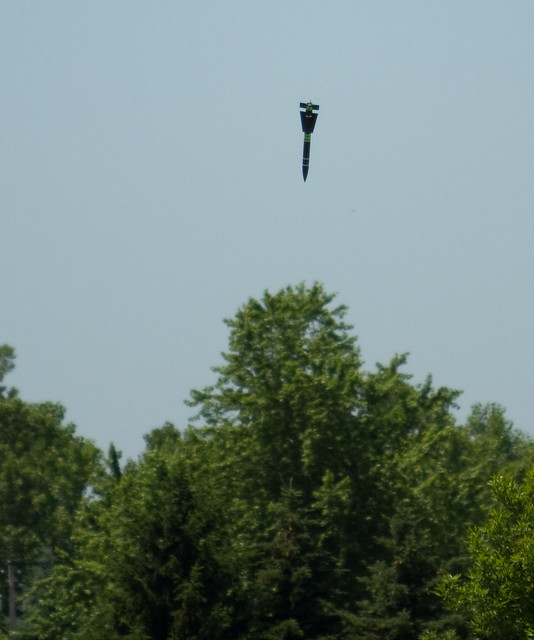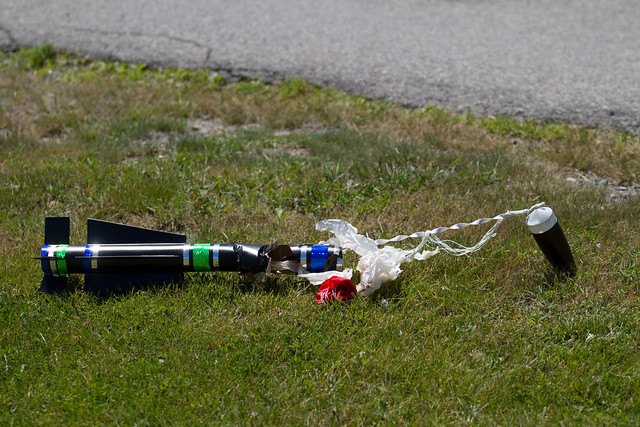1974_Trident
Well-Known Member
- Joined
- Dec 2, 2009
- Messages
- 176
- Reaction score
- 1
Yesterday Mr_Rocketeer and i had a great nearly windless day launching in spite of losing his Nova Payloader in a tree. We got close to a dozen launches in in about four hours and we were both getting tired. Our second favorite school launch field was becoming more populated too.
Two launches in particular need mentioning. A flight of my Estes Big Daddy on E9-4 and Mr_Rocketeer's Estes Hi-Flier XL on E9-6. Both rockets went cruise missile 200 feet after liftoff. Cruise missile flights are cool but I don't like having to chase a rocket over a quarter of a mile on a windless day and both rockets headed to crowded areas. The Big Daddy landed in a parking lot. The Hi-Flier XL landed in the middle of a football game. In both instances the shock cords snapped on ejection and both rockets were recovered UNDAMAGED. I was pleasantly surprised that the football players and spectators thought the arrival of the rocket was really cool and the rocket was moved to the sideline to prevent damage.
This got me thinking; We have had over the past three years five out of six flights on E9-4 and E9-6 engines go cruise missile on us. Until yesterday I thought we were experiencing weather-cocking. I do not expect weather cocking on a windless day. All rockets in question have consistently flown straight up on D-12 3 or 5. I have the spent case from a previous cruise missile flight and the two from yesterday. On close examination I noticed that the nozzle on one E9-4 seems damaged. The clay around the orifice is chipped and close examination shows striation in the chips which look like erosion radiating out from the center. The damage is asymmetrical and suggests to me that the thrust may have been asymmetrical for long enough to turn the flight horizontal. Another E9-4 doesn't have any erosion of the clay nozzle but the residue around the orifice is distributed asymmetrically. The E9-6 from yesterday's Hi-Flier XL flight looks like the orifice is partially clogged with residue. All of the E-9 engines in question were bought about three and a half years ago in the same purchase.
Has anybody here experienced or heard of similar failures of the Estes E9 engines? All of the searches I did on this forum turned up catastrophic failures of similar sized engines but that is not what we have experienced.
Two launches in particular need mentioning. A flight of my Estes Big Daddy on E9-4 and Mr_Rocketeer's Estes Hi-Flier XL on E9-6. Both rockets went cruise missile 200 feet after liftoff. Cruise missile flights are cool but I don't like having to chase a rocket over a quarter of a mile on a windless day and both rockets headed to crowded areas. The Big Daddy landed in a parking lot. The Hi-Flier XL landed in the middle of a football game. In both instances the shock cords snapped on ejection and both rockets were recovered UNDAMAGED. I was pleasantly surprised that the football players and spectators thought the arrival of the rocket was really cool and the rocket was moved to the sideline to prevent damage.
This got me thinking; We have had over the past three years five out of six flights on E9-4 and E9-6 engines go cruise missile on us. Until yesterday I thought we were experiencing weather-cocking. I do not expect weather cocking on a windless day. All rockets in question have consistently flown straight up on D-12 3 or 5. I have the spent case from a previous cruise missile flight and the two from yesterday. On close examination I noticed that the nozzle on one E9-4 seems damaged. The clay around the orifice is chipped and close examination shows striation in the chips which look like erosion radiating out from the center. The damage is asymmetrical and suggests to me that the thrust may have been asymmetrical for long enough to turn the flight horizontal. Another E9-4 doesn't have any erosion of the clay nozzle but the residue around the orifice is distributed asymmetrically. The E9-6 from yesterday's Hi-Flier XL flight looks like the orifice is partially clogged with residue. All of the E-9 engines in question were bought about three and a half years ago in the same purchase.
Has anybody here experienced or heard of similar failures of the Estes E9 engines? All of the searches I did on this forum turned up catastrophic failures of similar sized engines but that is not what we have experienced.





